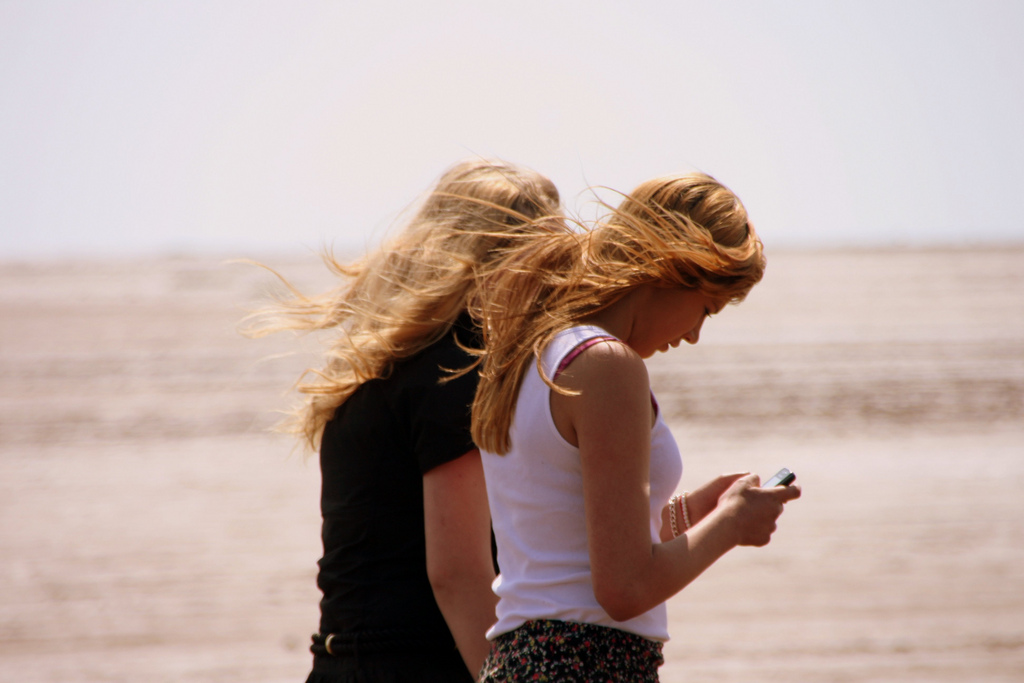Image by Pete, courtesy of Creative Commons.
Camila Fernandez and Paola Molini/FIUSM Staff
Gadgeteers wobble their way across campus hallways, trusting their peripheral vision to take them to class, the food court and even their car safely.
According to a recent study by the journal Accident Analysis and Prevention, over 1,500 pedestrians across the country have found themselves in an emergency room from simultaneously walking and using their cellphones.
A study by Ohio State University reported that those between the ages of 16 and 25 have the highest risk of being injured.
As students walk throughout the campus, they are often distracted by a Facebook update, or a new “tweet” from their Twitter. Some experience the embarrassing mishap of hitting themselves against objects ahead of them.
“Yea, I was texting and I didn’t notice where I was walking. Thank God it didn’t go to my face, but I did hit my shoulder with a poster, or whatever it was,” said Priscila Omlion, a junior public relations major. “But I’ve never eaten the floor.”
Some have tried triple-tasking.
Denia Abreu, a freshman psychology major, said she was texting while walking to her car from the mall while also holding a drink when learned to look where she walks.
“I didn’t look up and I bumped into a walking sign, and I hit my head really hard,” Abreu said.“And I dropped the drink.”
Students at Biscayne Bay Campus walk around school facilities underestimating the risks of distorted movements, off-balance walking and irregular posture derived from texting and walking.
Research by Plos ONE concluded that texting significantly distorts people’s gait and walking form, whether they intended to contort themselves or not.
The study also shows that texting and walking can cause or worsen neck and shoulder pain. It also shows that normally, the body prioritizes maintaining balance above all other demands, but in this research study bodies and brains appear to be “prioritizing texting.”
Daniel Lipson, a hospitality senior said he has a “horrible habit” of texting while he is on his skateboard and although he consider his behavior rude and dangerous, he attributes texting and walking to the social awkwardness of people.
Lipson says people do not know how to communicate personally and they have a need to hide behind their phones.
“We are losing focus on personal values and the appreciation of nature,” Lipson said.
According to a recent study published by the Journal of Behavioral Addictions, 90 percent of U.S. college students check their cell phones at an average of 60 times per day, making its constant use a rising epidemic.
This idea of being “attached” to our phones has created a new idea called “Nomophobia”, by a UK-based research organization. It’s the abbreviation for “no-mobile-phone phobia,” it’s the fear of being separated from mobile contact.
“You ask an addict if they’re addicted to it, they’ll tell you no,” said Jorge Lorente, a junior information technology major.
“It’s like opening a refrigerator at your house. You know it’s not going to change, but you keep on opening it,” he said, referring to the ongoing usage of cell phones for new information.
Jaqueline Rios, a biology senior said she doesn’t have a specific reason to text and walk but she thinks the trend has a lot to do with the influence of technology in students.
“I think people are just so used to having their phones,” Rios said. “We are so involved with technology it’s hard to be without it all of the sudden.”
For other students, having access to text messaging and video chats at the palm of their hands is not an excuse for texting and walking or being in tune with the rest of the world all the time.
“People don’t really care about the consequences of their actions, they’re more concerned with what they have to get done in the moment,” said Alejandro Escobedo, broadcast senior. “You have people that are texting and walking and can cause accident, but they don’t think about it that way, they only worry about what their next assignment is and whom they then can contact to help them.”
Escobedo said he doesn’t text and walk. In fact, he thinks texting and walking can most of the times lead to texting and driving.
“If you’re texting and walking on the way to your car you could be persuaded to continue that conversation as you drive,” Escobedo said.
“We move in a fast world, everyone has a job and some people go to school. It seems like it never ends, but honestly, some things… they can just wait.”
A new study conducted by the University of Maryland concluded that most college students are not only unwilling to be disconnected, but are functionally unable to seclude themselves from their media links.
The study reported that students are mainly affiliated to the media in order to stay continuously connected with their friends and family.
“I just log on when I get the chance. I open Instagram, then it’s Twitter, than Facebook. It becomes a cycle,” said Amanda Montesino, a junior psychology major.
“It’s very hard to ‘blame’ social media or technology for death, injury, or even distraction from parts of our lives – including driving, texting, or even addiction,” said Robert Gutsche, a journalism and broadcasting professor.
“There’s no computer monster making people use these things. Instead, just as always, people seem to put themselves — and their Facebook profiles — above the interests and needs of larger society.”
bbc@fiusm.com






Be the first to comment on "Study reveals detrimental effects of texting and walking"